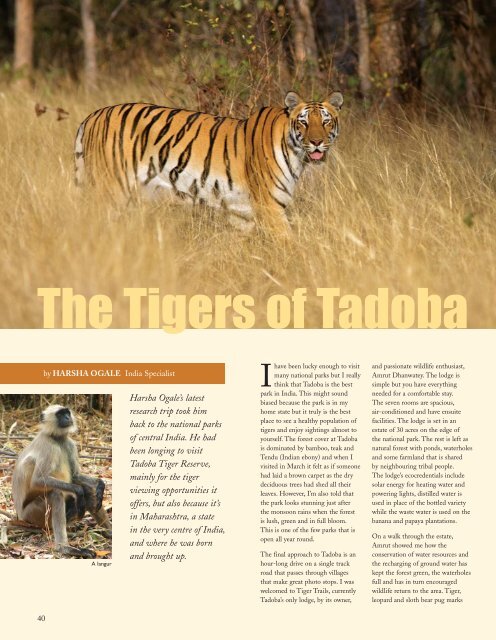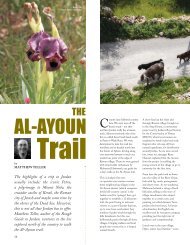Download this article as a pdf - Audley Travel
Download this article as a pdf - Audley Travel
Download this article as a pdf - Audley Travel
You also want an ePaper? Increase the reach of your titles
YUMPU automatically turns print PDFs into web optimized ePapers that Google loves.
The Tigers of Tadoba<br />
40<br />
by HARSHA OGALE India Specialist<br />
A langur<br />
Harsha Ogale’s latest<br />
research trip took him<br />
back to the national parks<br />
of central India. He had<br />
been longing to visit<br />
Tadoba Tiger Reserve,<br />
mainly for the tiger<br />
viewing opportunities it<br />
offers, but also because it’s<br />
in Mahar<strong>as</strong>htra, a state<br />
in the very centre of India,<br />
and where he w<strong>as</strong> born<br />
and brought up.<br />
Ihave been lucky enough to visit<br />
many national parks but I really<br />
think that Tadoba is the best<br />
park in India. This might sound<br />
bi<strong>as</strong>ed because the park is in my<br />
home state but it truly is the best<br />
place to see a healthy population of<br />
tigers and enjoy sightings almost to<br />
yourself. The forest cover at Tadoba<br />
is dominated by bamboo, teak and<br />
Tendu (Indian ebony) and when I<br />
visited in March it felt <strong>as</strong> if someone<br />
had laid a brown carpet <strong>as</strong> the dry<br />
deciduous trees had shed all their<br />
leaves. However, I’m also told that<br />
the park looks stunning just after<br />
the monsoon rains when the forest<br />
is lush, green and in full bloom.<br />
This is one of the few parks that is<br />
open all year round.<br />
The final approach to Tadoba is an<br />
hour-long drive on a single track<br />
road that p<strong>as</strong>ses through villages<br />
that make great photo stops. I w<strong>as</strong><br />
welcomed to Tiger Trails, currently<br />
Tadoba’s only lodge, by its owner,<br />
and p<strong>as</strong>sionate wildlife enthusi<strong>as</strong>t,<br />
Amrut Dhanwatey. The lodge is<br />
simple but you have everything<br />
needed for a comfortable stay.<br />
The seven rooms are spacious,<br />
air-conditioned and have ensuite<br />
facilities. The lodge is set in an<br />
estate of 30 acres on the edge of<br />
the national park. The rest is left <strong>as</strong><br />
natural forest with ponds, waterholes<br />
and some farmland that is shared<br />
by neighbouring tribal people.<br />
The lodge’s ecocredentials include<br />
solar energy for heating water and<br />
powering lights, distilled water is<br />
used in place of the bottled variety<br />
while the w<strong>as</strong>te water is used on the<br />
banana and papaya plantations.<br />
On a walk through the estate,<br />
Amrut showed me how the<br />
conservation of water resources and<br />
the recharging of ground water h<strong>as</strong><br />
kept the forest green, the waterholes<br />
full and h<strong>as</strong> in turn encouraged<br />
wildlife return to the area. Tiger,<br />
leopard and sloth bear pug marks
Left: A Bengal tiger in a gr<strong>as</strong>sland at<br />
Tadoba Tiger Reserve india<br />
Below: Four horned Antelope female<br />
can be seen within 500 feet of the<br />
lodge and carnivore kills are<br />
frequently spotted in the<br />
surrounding scrub. The estate h<strong>as</strong><br />
machans (stilted observation huts)<br />
overlooking the water holes, offering<br />
undisturbed wildlife viewing.<br />
After the walk we sat down for a<br />
chilled beer and Amrut told me a<br />
funny story about the machan we<br />
saw earlier. He once spent the night<br />
in it to observe and photograph<br />
wildlife in the jungle but the machan<br />
collapsed <strong>as</strong> he tried to photograph<br />
a leopard in the waterhole beneath<br />
him! He h<strong>as</strong> since rebuilt the<br />
machan with a strong metal frame!<br />
Like other parks in India, Tadoba<br />
offers morning and afternoon safaris.<br />
These are arranged in private jeeps<br />
and either Amrut or his son Aditya,<br />
act <strong>as</strong> accompanying naturalist.<br />
We entered the park at 6:30am and<br />
I w<strong>as</strong> <strong>as</strong>tonished to see that ours w<strong>as</strong><br />
the only jeep at the Khutwanda gate.<br />
We drove down a tar road that runs<br />
through the forest. It is lined with<br />
imposing stone pillars, a remnant of<br />
the reign of the Gond Kings from<br />
the 12th to the 18th century.<br />
Originally each pillar had a bell<br />
attached and formed a means of<br />
communicating to the surrounding<br />
area that the King w<strong>as</strong> travelling<br />
through the forest and that the path<br />
should be cleared.<br />
Soon, in one of the side lanes our<br />
observant driver Lahu spotted four<br />
tiger cubs. It w<strong>as</strong> only my first game<br />
drive here and I had already seen<br />
four healthy cubs! Wow! On my next<br />
two game drives we saw four male<br />
tigers, one female, four cubs, two<br />
leopards, and a sloth bear <strong>as</strong> well <strong>as</strong><br />
numerous birds. At Tadoba you see<br />
everything from butterflies to big<br />
cats, a sign that the park h<strong>as</strong> a very<br />
healthy ecosystem. Due to the<br />
consistent efforts of people like<br />
Amrut, the Chichghat valley h<strong>as</strong><br />
grown thicker and denser attracting<br />
smaller wildlife like peafowl,<br />
jungle fowl, monitor lizards, hares,<br />
partridges and quails, which had<br />
almost disappeared, but today can be<br />
frequently spotted or at le<strong>as</strong>t heard.<br />
The next day, Amrut took me on a<br />
short walk through the farmland<br />
adjoining his estate. I w<strong>as</strong> really<br />
happy to see the good relationship<br />
he h<strong>as</strong> formed with the local<br />
villagers. Before he set up home here<br />
the land w<strong>as</strong> barren and deforested<br />
but after establishing plant nurseries<br />
with the help of the local people,<br />
they replanted local forest species<br />
and recreated the natural forest and<br />
gr<strong>as</strong>slands. Amrut continues to<br />
support the farmers by providing<br />
them with good quality seeds and<br />
manure and then buying back the<br />
vegetables they produce. The tribal<br />
cooks offer an array of different<br />
cuisines: dishes local to the area,<br />
more mainstream Indian food and,<br />
for those that crave it, a proper full<br />
English breakf<strong>as</strong>t!<br />
The safari on my l<strong>as</strong>t day surp<strong>as</strong>sed<br />
each and every tiger sighting I have<br />
previously had: I saw an adult male<br />
tiger making a kill in one of the less<br />
explored are<strong>as</strong> of the park. The tiger<br />
growled several times <strong>as</strong> if he w<strong>as</strong><br />
celebrating his victory. What an<br />
experience! We were all awestruck.<br />
As Amrut says ‘When it comes to<br />
wildlife be extremely patient and<br />
before you know, nature will do its<br />
best to make your day’. More than<br />
satisfied with <strong>this</strong> experience we<br />
began our return to the lodge when<br />
a leopard crossed in front of us. I<br />
have seen leopards at Pench and<br />
S<strong>as</strong>an Gir National Parks but never<br />
had such a clear sighting. This w<strong>as</strong><br />
literally the icing on the cake. Amrut<br />
couldn’t stop laughing <strong>as</strong> he couldn’t<br />
believe our good luck. It w<strong>as</strong> <strong>as</strong> if<br />
nature w<strong>as</strong> trying to show off.<br />
41
The Tigers of Tadoba<br />
Other national parks in Central India<br />
After having such an incredible experience at Tadoba, I continued<br />
on my journey to revisit some of the more popular wildlife reserves<br />
in Central India: Bandhavgarh, Kanha and Pench National Parks<br />
along with the less well known Satpura.<br />
Bandhavgarh National Park<br />
There haven’t been any major changes at Bandhavgarh recently<br />
and it still offers good tiger sightings. One drawback is that it can<br />
be crowded at times but the new opportunity to combine two<br />
routes on an afternoon safari incre<strong>as</strong>es your chances of seeing<br />
wildlife <strong>as</strong> you are able to cover a much bigger area than before.<br />
There are also a few new lodges which offer a greater variety of<br />
accommodation choice too.<br />
Kanha National Park<br />
My next stop w<strong>as</strong> Kanha which I thoroughly enjoyed. A few more<br />
lodges have been established but they are small, rustic and very<br />
much in keeping with their surroundings and the local architectural<br />
style. Their setting is beautiful and the lodge owners seem to have<br />
realised that quality is better than quantity, so the majority of the<br />
new places have just four or six rooms.<br />
Recently, a new zone called Sarhi h<strong>as</strong> opened to visitors, and<br />
although tiger sightings in <strong>this</strong> area are rare, the scenery is<br />
outstanding and the terrain is very different to that in the other<br />
zones so its well worth spending some time here to enjoy the<br />
variety of other wildlife it offers.<br />
Pench National Park<br />
A beautiful Indian roller, Pench National Park<br />
Although visitor numbers here haven’t incre<strong>as</strong>ed much the park is<br />
busy at weekends <strong>as</strong> it’s just two hours’ drive from Nagpur and<br />
therefore attracts local visitors. The park still offers a good standard<br />
of mid-range and luxury accommodation.<br />
Satpura National Park<br />
Finally, on the l<strong>as</strong>t leg of my journey I visited Satpura. This w<strong>as</strong><br />
really exciting <strong>as</strong> I w<strong>as</strong> able to go on a walking safari, an activity<br />
which can’t be done in any other park in India. Although I w<strong>as</strong>n’t<br />
<strong>as</strong> lucky with my sightings <strong>as</strong> some Dutch visitors who saw a<br />
leopard and two cubs, it w<strong>as</strong> still an excellent experience to be out<br />
on foot in the jungle. It is also possible to take an elephant safari<br />
which w<strong>as</strong> simply amazing. We got off the jeep tracks and plunged<br />
directly into the jungle, the mahout commanding the elephant to<br />
clear his path <strong>as</strong> needed. A boat ride on the Tawa Reservoir, which<br />
attracts a huge range of species, is a must for twitchers. There are<br />
only two lodges at Satpura. Forsyth’s Lodge which h<strong>as</strong> only been<br />
open for just over a year h<strong>as</strong> already received excellent feedback<br />
from our clients and the newly opened Reni Pani which offers a<br />
high standard accommodation. Spread across the Satpura Hills and<br />
with its with numerous waterholes, ponds and lakes, <strong>this</strong> park is<br />
truly beautiful and offers various activities that make it an<br />
interesting and worthwhile addition to any wildlife tour.<br />
Comfortable air conditioned rooms at Tiger Trails, Tadoba<br />
42
A adult male resting in a water, Tadoba National Park<br />
Responsible <strong>Travel</strong><br />
Prakratik Society<br />
In Ranthambhore National Park, we support the Prakratik Society<br />
through our work with Friends of Conservation. They have<br />
developed unusual methods of protecting tiger habitat by setting up<br />
an artificial insemination programme for cattle. This aims to reduce<br />
the number of cows roaming freely through the park, therefore<br />
combatting the tension caused by tigers killing cattle. It h<strong>as</strong> also<br />
helped reduce the environmental damaged caused by grazing cattle,<br />
whilst also supporting the farmers who benefit from incre<strong>as</strong>ed milk<br />
yields and healthier cattle.<br />
TOFT<br />
Tour Operators For Tigers is a scheme where travel companies<br />
donate £15 per person towards tiger conservation in the National<br />
Parks of India. We support <strong>this</strong> scheme and donate the money<br />
collected on an annual b<strong>as</strong>is.<br />
FACTfile<br />
■ A 12 day tour including return<br />
international flights from London,<br />
accommodation on full board<br />
b<strong>as</strong>is with game drives and<br />
activities in Tadoba and<br />
Bandhavgarh national parks costs<br />
from £2,435 per person b<strong>as</strong>ed<br />
on two people sharing.<br />
■ For details contact Harsha Ogale<br />
on 01993 838 306.<br />
www.audleytravel.com/india<br />
A beautiful bee eater spotted at Kanha<br />
WEBplus<br />
Find out more about the<br />
wildlife of India with our interactive<br />
guide to the best parks and when to<br />
go. Watch a video interview with one<br />
of our Indian wildlife specialists.<br />
www.audley.co.uk/traveller/summer2010<br />
43
















